How to Catch Smallmouth Bass: Complete Guide to Techniques, Gear, and Locations
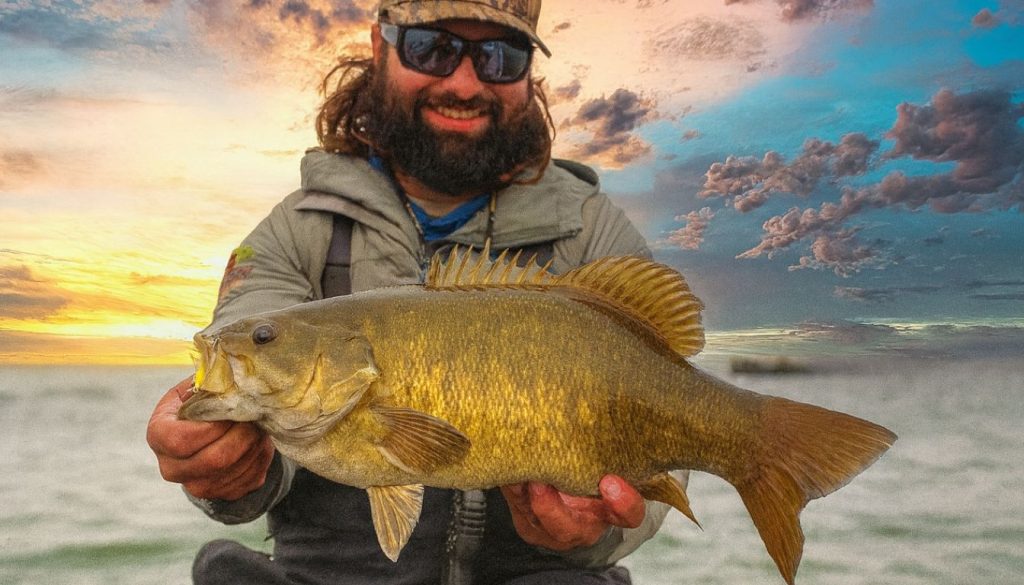
Species Profile
Quick Identification
Scientific Name & Common Names: The smallmouth bass (Micropterus dolomieu) is often called bronzeback, brown bass, smallie, or bareback bass.
Smallmouth bass are streamlined and muscular, with an olive-brown to greenish body and bold dark vertical bands. Unlike largemouth bass, the smallmouth’s upper jaw reaches only to the middle of the eye, and its two dorsal fins are joined by just a shallow notch. A reddish eye with three distinct dark stripes radiating from it is also characteristic. (Image: Underwater view of a smallmouth bass.)
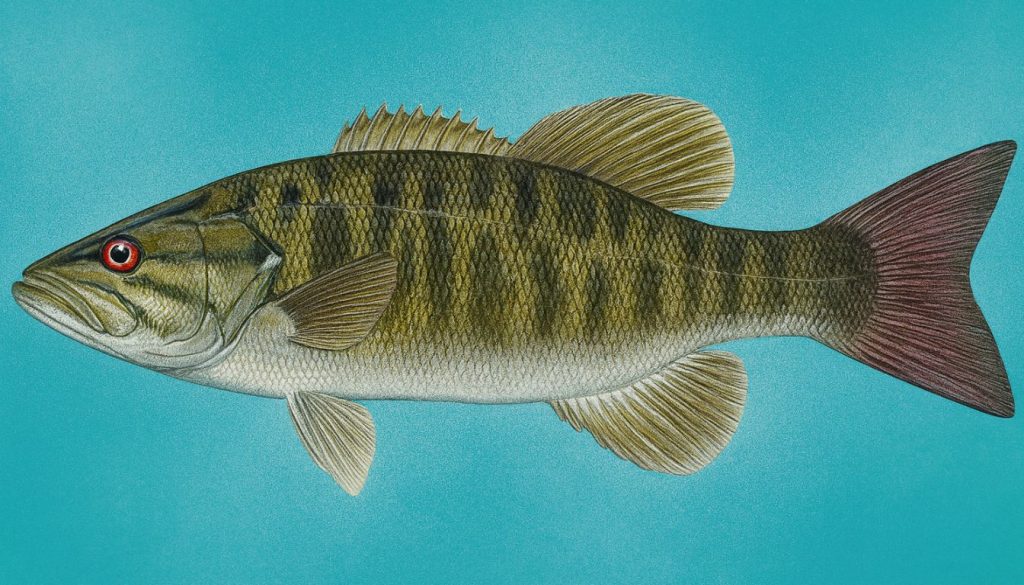
Size & Records: Adults typically run 12–16 inches (30–40 cm) long and weigh 1–5 lbs. Larger females can approach 27 inches (69 cm). Weights over 5 lbs are prized trophies; the IGFA all-tackle world record is 11 lb 15 oz (5.41 kg) from Tennessee’s Dale Hollow Lake.
Why Target This Species
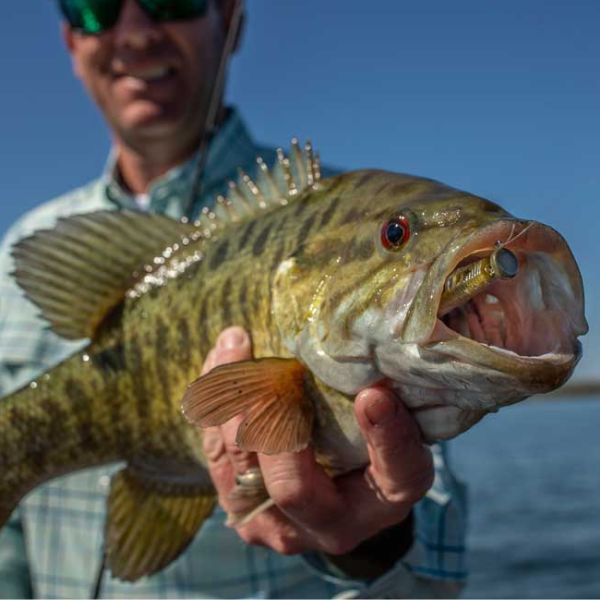
Skill Level: Smallmouth bass fishing is generally an intermediate-level pursuit. These fish are known for their tenacious, powerful strikes and endurance (one guide calls them “among the sportiest freshwater fish”), so landing them requires finesse and proper tackle.
Sport & Culinary Value: Smallmouth are extremely popular sportfish in the U.S. Anglers prize them for their fight, often practicing catch-and-release on trophy-sized bass. Their flesh is lean and mild; they make decent table fare, but many anglers target smallmouth more for sport than for eating.
Peak Season: Best fishing usually comes in spring and fall. Smallmouth spawn in late spring when water reaches about 15–18°C, concentrating in shallow gravel flats. In cooler autumn (water in the 60s°F), they feed aggressively to fatten up for winter. Summer can still produce fish, but the bites often shift deeper.
Behavior and Feeding
Hunting Pattern
Feeding Method: Smallmouth bass are ambush predators. They lurk near cover (rocks, submerged wood, drop-offs) and dart out to snatch prey. They tend to stick close to structure where they can quickly ambush smaller fish or crustaceans.
Activity Times: They exhibit distinct crepuscular patterns – most feeding occurs at dawn and dusk. Many anglers find early morning and late afternoon to be the most productive hours. Low-light conditions (overcast skies, shaded banks) also often extend feeding into the day.
Social Behavior: Typically, smallmouth bass are found solitary or in small groups. However, in fall they often school more tightly by size. Once you locate a fall shoal, you may catch several fish in succession. Outside of these feeding aggregations, bass tend to be territorial or loosely associated with other fish.
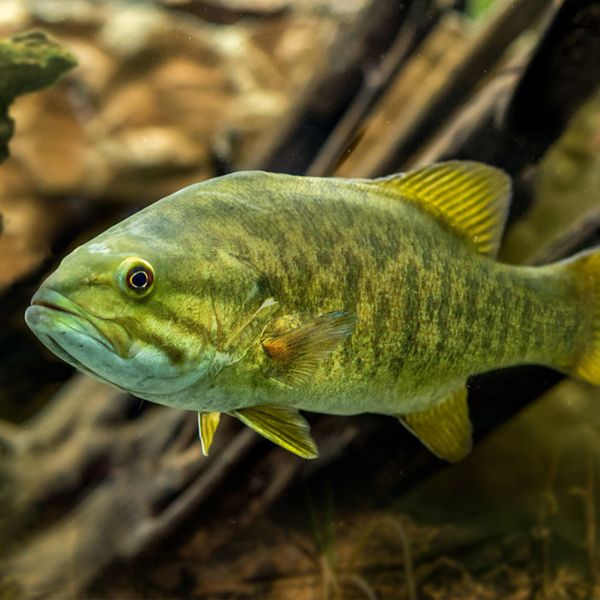
Primary Diet
Smallmouth Bass Diet Guide
Master the waters by understanding what smallmouth crave
🦞 Primary Food Sources
Spring & Summer
Fall & Winter
🎣 Effective Bait & Lure Selection
- Brown/orange plastic jigs
- Craw-pattern crankbaits
- Tube baits in natural colors
- Jig & craw combos
- Minnow plugs
- Spinnerbaits
- Shad-pattern swimbaits
- Small crankbaits
- Small soft-plastic worms
- Tube baits (dark colors)
- Ned rigs
- Stick baits in natural tones
💡 Pro Tips for Success
Where and When to Find Them
Key Habitat
Structure: Smallmouth bass favor clear, cool water with plentiful cover. Prime habitat includes rocky shorelines, gravel bars, boulder fields, ledges and points. Submerged timber, docks, and even man-made structures (like riprap) can hold fish. Essentially, any structure near a drop-off or deeper channel break is a likely ambush point.
Depth by Season: In spring (pre-spawn/spawn), smallmouth move shallow to spawn (often 3–15 ft deep). In summer, most retreat to deeper water (often 10–40+ ft) where it stays cool. Fall sees them moving shallower again (15–20 ft on points/rails) as they feed, but many remain at mid-depths. In winter they hold in the deepest holes and slow river pools.
Habitat Zones: In streams and rivers, look for gravel-bottom riffles and runs, pools below riffles, and current breaks (behind rocks or in eddies). In lakes/reservoirs, focus on rocky shorelines, shoals, points, drop-offs and creek mouths. Because smallmouth need clean water, classic hotspots include Northern lake regions (Great Lakes, Adirondacks) and spring-fed streams (Ozark streams, Appalachian rivers). Note that smallmouth tolerate stronger current than largemouth.
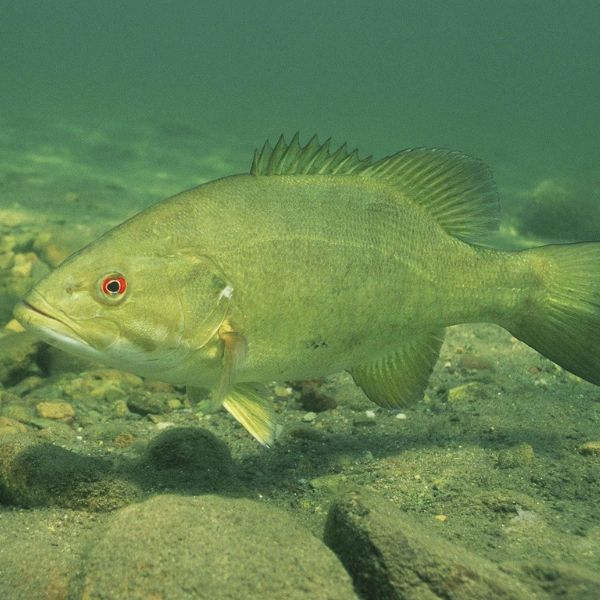
Distribution: Native to the St. Lawrence–Great Lakes and upper Mississippi drainage, smallmouth have been widely stocked. Today they occur in most U.S. states (especially northern and upland waters) wherever suitable habitat exists. In the Southeast they populate tailwaters and clear impoundments (e.g. Dale Hollow, Chattahoochee River). In the Midwest/Northeast, prime waters include Lake Champlain, Lake Ontario/St. Lawrence, Boundary Waters lakes, and many Ozark rivers.
Fishing Calendar
🐟 Smallmouth Bass Seasonal Calendar
Year-round guide to peak fishing times and techniques
Spring
Summer
Fall
Winter
Optimal Conditions
- Time of Day: Dawn and dusk are typically most productive. Smallmouth often rise to feed in low light, so focus early and late. Cloudy or overcast skies can trigger more daytime activity.
- Water Conditions: Clear water is ideal for smallmouth; they become shy in stained or muddy water. Flow (in rivers) and wave action (in lakes) that oxygenate the water can stimulate feeding. Moderate currents and stabilized lake levels are good; rising water (after rain) can push fish onto new feeding flats.
- Weather: Mild weather and light to moderate barometric changes are best. Avoid fishing when water temperatures are extremely high (above ~80°F), as bass become stressed. Slight chop or ripple on the surface often improves feeding compared to glassy calm conditions.
Gear and Techniques
Recommended Setup
Primary (Finesse) Setup: A 6½–7 ft medium-light spinning rod paired with a smooth, fast-action reel is an excellent all-around smallmouth outfit. Spinning gear lets you cast small jigs, soft plastics, and drop-shot rigs with finesse. Use 6–10 lb fluorocarbon line in clear water for stealth. This light tackle lets you feel subtle bites and present small lures accurately.
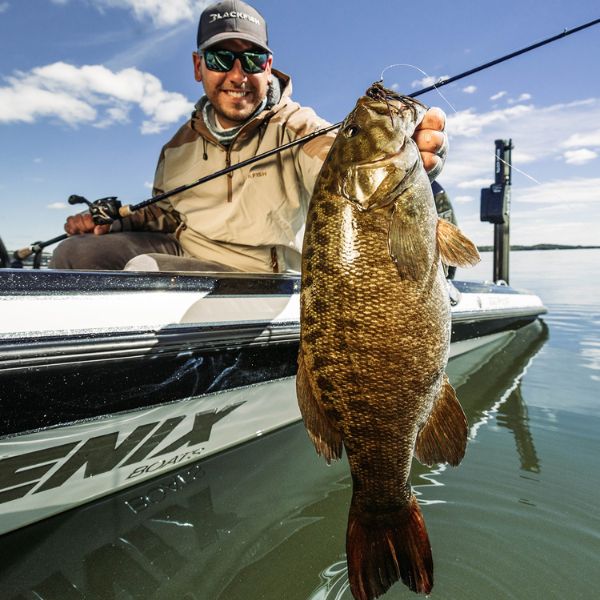
Heavy Cover/Trophy Setup: For fishing heavy rock or wood (or targeting big fish), a 7–7½ ft medium-heavy baitcasting rod (7.5:1 or higher gear ratio) is preferred. Spool it with 10–20 lb braided line tied to a fluorocarbon leader. This setup can fire heavy jigs/crankbaits and muscle fish away from snags. The braid provides sensitivity and power, while the fluorocarbon leader is abrasion-resistant.
Line Selection: Fluorocarbon (6–12 lb) is ideal for finesse presentations and clear water. For flipping heavy cover, braid (12–20 lb) is common because it cuts through tangles. Always match line strength to lure size and cover — the guide Dr. Neal notes heavier gear improves survival and landing rate by shortening fight time.
Alternative Setup: In small streams or for precise work, a short 6′ rod with 4–8 lb line can improve accuracy. For extreme deep-water fishing, a fast retrieval reel (e.g. 7:1 baitcaster) with 8–10 lb mono (to eliminate memory and stretch) may be used.
Effective Baits and Lures
Top 3 Natural Baits:
- Live Crayfish: Rig a fresh crawdad on a slip float or a simple jig head. Hook it through the tail and let it swim naturally near bottom. This imitates the bass’s favorite prey. In streams, drift live crayfish in current pools; in lakes, cast them along rock ledges.
- Minnows/Shiners: Small live baitfish (yellow perch, chubs or shiners) on a tiny treble or circle hook under a float can catch lots of smallies. Rig the bait lightly so it can swim freely. Fish these near drop-offs or in deep pockets of the river, especially at dawn/dusk.
- Nightcrawlers/Leeches: Common earthworms or leeches work well. Present them on a small hook with or without split shot. You can Texas-rig a plastic worm as a substitute. This is especially effective in stained water or current: drift a redworm under a bobber through deep pools.
(These baits mimic the bass’s main diet of crayfish, small fish and insects.)
Essential Lures:
Jigs & Soft Plastics: A finesse or tube jig tipped with a crawfish- or creature-style soft plastic is indispensable. Drag or hop this along rocks and gravel (like a fleeing crayfish). Football-head jigs with craw or grub trailers are great on flats. Use 3–5″ plastics in natural crawfish colors (brown, green pumpkin). Drop-shot rigs with 3–4″ worms or minnows work well in deeper water or cold months.
Hard-Plastic Lures (Crankbaits/Jerkbaits): Crankbaits in crawfish or shad patterns are excellent for covering water. Shallow-running crankbaits (like jerkbait/plug style) can trigger strikes on flats in spring/fall. Medium-to-deep diving crankbaits (10–20 ft) are effective on summer drop-offs. Colors like silver-blue or white (shad patterns) and brown/gold (crawfish patterns) are proven. In spring/fall, twitching a minnow-imitating jerkbait with pauses draws strikes.
Topwater Lures: In low-light or warm-season situations, surface lures can produce explosive bites. Walking baits (poppers or stickbaits) and poppers in dark green, brown or white are favorites. Work them across rocky flats or under docks at dawn/dusk. (Smallmouth will often eagerly strike a topwater plug in the early morning or evening.)
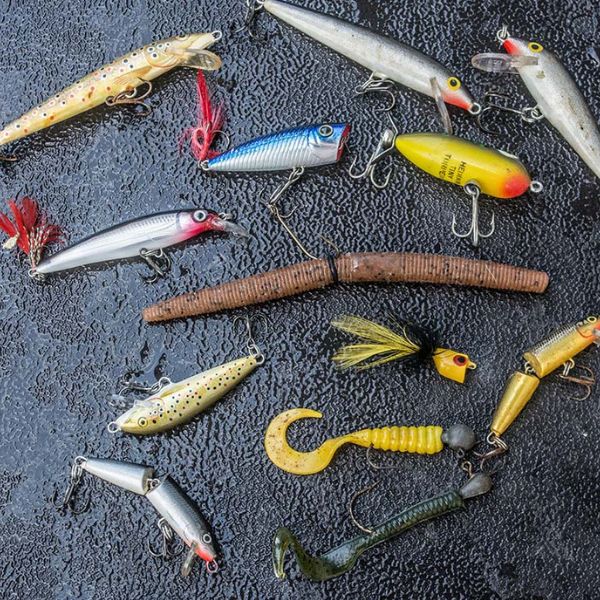
Fishing Techniques
Dragging/Hopping Jigs: Cast your jig (tube, Texas-rigged worm or creature bait) just past rocks or cover. Let it sink fully, then slowly drag or hop it across the bottom. Occasionally pause the retrieve so the jig sits motionless – this “fleeing crayfish” presentation often triggers strikes. In winter or cold water, use very slow, subtle hops.
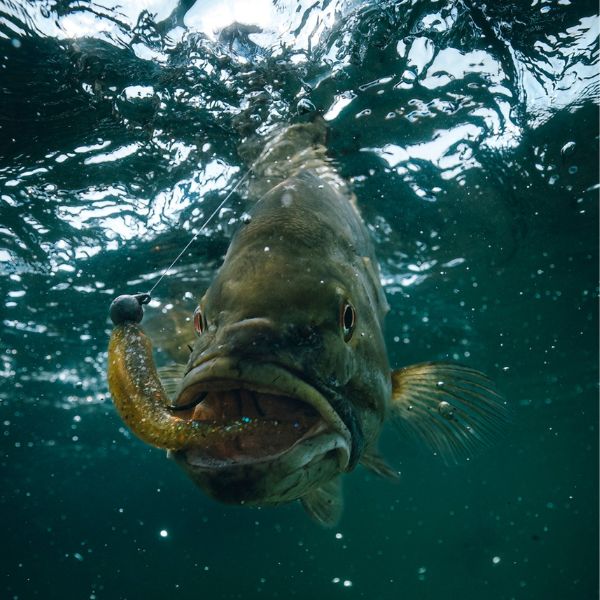
Crankbait Retrieve: For crankbaits, cast at an angle across a flat or point. Use a steady medium-speed retrieve in cool water; in warmer water try a stop-and-go twitching motion to mimic a panicked baitfish. Always vary your speed – if fish hesitate, try a slower retrieve or a jerkbait twitch. Change depths (switch from shallow to medium divers) to find active fish.
Drop-Shotting: Rig a small soft plastic or minnow on a drop-shot hook above a weight. Cast into deep pockets and let it sink vertically. Keep slight tension and gently twitch the rod tip so the bait “dances” a foot above the bottom. This is ideal for prespawn or summer smallmouth in deep water.
Drift Fishing (Rivers): In moving water, cast upstream and let your bait/rig drift naturally into holding areas (holes, behind rocks). Keep a little rod bend to feel the drifted lure. This hands-off presentation is very effective for finicky bass. Drift a jig or plastic slowly with the current and set the hook as soon as it touches bottom.
Flipping/Pitching (Heavy Cover): When bass hide in heavy cover (wood, docks, dense weeds), use braided line and heavy jigs. Flip the bait with a short underhand cast to touch down quietly. After hooking a fish, reel in any slack immediately and lift the rod tip to break free from snags.
- Pro Tips: Always keep your line tight and rod tip up when a bass strikes to set the hook instantly. Sharpen hooks regularly and pinch down barbs for easier releases. Vary lure size and color if bites are sluggish. Pay attention to your lure hitting bottom – if you bounce off rocks, you know you’re in the fish zone and should reel slowly.
Catch and Handling
During the Fight
Fight smallmouth bass patiently: These fish fight hard, often making runs or diving toward cover. Keep your rod tip up and apply steady pressure. Don’t try to muscle them out too quickly or they may jerk the lure loose; instead, use a pump-and-reel motion to “walk” the fish in. Be ready to steer them away from snags by quick, soft rod twitches.
A common mistake is reeling too fast or using too light tackle – if the bass gets under a log or deep weeds, it can throw the hook. Use just enough drag so the fish can run a little without breaking the line, then reel to absorb its head shakes.
For trophy bass, it can help to turn the fish sideways in the water (using the rod) once it’s tired, so its body resistance slows its final run. Once it’s near the boat or bank, scoop it with a net or “boat-flip” it by guiding it into your hands (supporting it as described below).
Catch and Release
Handle smallmouth with care to maximize survival. Minimize their time out of water – ideally photograph or measure quickly (under 1–2 minutes) and keep the fish supported wet. Wet your hands or use a soft, knotless net to protect their slime coat. Support the fish horizontally: slide one hand under the belly and, if needed, the other at the tail or jaw (never dangle by the jaw alone).
Use barbless or single hooks whenever possible; flattening the barb or using circle hooks greatly reduces deep swallowing and injury. If a bass is deeply hooked, cut the line close rather than forcing the hook out. Fight the fish quickly – research shows that shorter fights (using adequately heavy gear) greatly improve post-release survival.
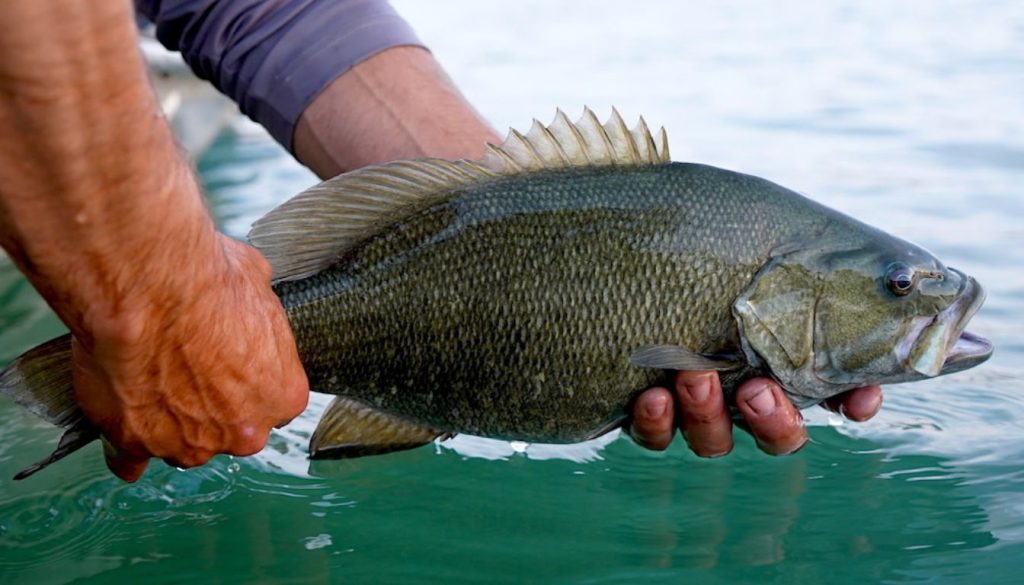
Do not fish in very warm water and always release the fish gently headfirst into the current or well-oxygenated water to revive it. (Remember: less than 2 minutes of air exposure is a good rule.) Following these guidelines will help ensure your released smallmouth swim away strong.
For Consumption
If you intend to keep smallmouth for eating, dispatch them humanely and preserve their quality. The most common method is a quick blow to the head or a spike (ikejime) to the brain, which instantly kills the fish.
If you practice catch-and-release on others, ensure the sacrificed fish is bled immediately: cut the gills or make a small incision at the tail root and let blood drain (this results in firmer, better-tasting meat). Always handle the kept fish gently: gut them promptly and immerse them in ice water or on ice immediately.
Do not leave the fish in the sun or in a warm vehicle. Proper cooling preserves the flesh and taste. A good tip is to keep the fish cool before fighting it – laying it on ice right after hooking (using a long-handled net to minimize stress) will maximize meat quality.
Sources: Authoritative fisheries and angling guides; U.S. Fish & Wildlife Service data
state wildlife and university publications
angling resources (FishUSA, BassForecast, BassResource) on smallmouth habits and tactics
bassresource.com. These sources were used for species facts, behavior, gear recommendations, and techniques. Uncited fishing advice is based on standard catch/handling practices and expert angler consensus.
